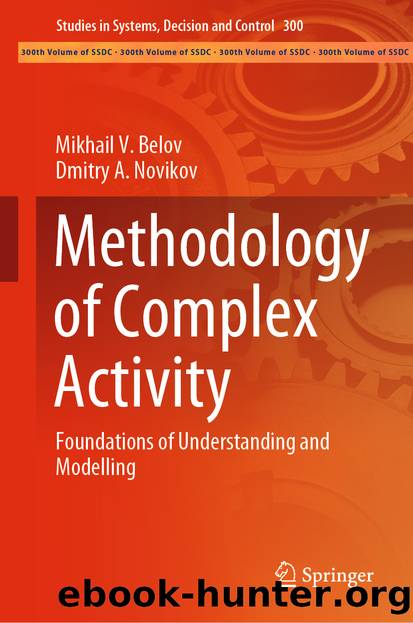Methodology of Complex Activity by Mikhail V. Belov & Dmitry A. Novikov

Author:Mikhail V. Belov & Dmitry A. Novikov
Language: eng
Format: epub
ISBN: 9783030486105
Publisher: Springer International Publishing
e.The activity is terminated; the actions provided by the technology are not completed.
f.Reaction to the event of true uncertainty, which occurred earlier.
All possible transitions are reflected in the diagram of Fig. 4.8.
The state a is the initial one, corresponds to the time interval when the SEA subject decided to perform the activity, but the activity has not yet been started. The state b corresponds to the successive execution of all stages of the SEA’s CC. When an event of measurable (or true) uncertainty occurs, a transition to the d—arrow from b to d occurs (transition to the state f from b to f)—a reaction to the uncertainty event occurs. As a result of the reaction to the uncertainty, a return to a routine performance (arrows from d or f to b) may occur, or there may be another event of uncertainty on which the reaction will be performed (arrows from d to f or from f to d), or will be accepted the decision that a regular continuation of activity is impossible and it must be stopped (arrows from d to e or from f to e). In the event that during the CA realization the events of uncertainty did not occur, all the actions provided by the technology are successfully completed—the arrow from b to c. States c and e are terminal, the transition to them actually means the continuation of the SEA in the form of historical data, and the result of the CA, of course.
The fixing of events of uncertainty is carried out by the subject, both directly and indirectly, as a result of escalating problems by subjects of lower-level SEAs.
The response to events of uncertainty implementation may result in the generation of new SEAs or in the transmission of information on the escalation of the problem to the higher SEA.
The model of uncertainty implementation is a generalizing model that represents all the classes identified above—regular, replicative and creative CA. This model in the form of a state diagram and possible transitions between them is methodically close to the formalisms of cellular automata and discrete event system (Discrete Event System Specification) [96], widely used for modeling complex systems. Together with the SEA formalism and the structural models cited above, the model for the realization of uncertainty forms a set of models representing various aspects of complex activity. In the next chapter, models of life cycles of CA, integrating structural models and models of activity generation, will be presented.
In conclusion of this chapter, it makes sense to return to the trend of regularization of activity, identified in detail and discussed in detail above (Sect. 4.2), which in fact consists in the “cognition of complex activity” of fixing and systematizing knowledge about it. In fact, this work and Chap.3 in particular is an example of regularization: the identification and fixing of system-wide regularities of complex activity is nothing but the first step in the regulation of activity. Moreover, since all classes of CAs are considered, regulation is also subject to creative activity, which is distinguished by an exceptionally high level of a priori uncertainty.
Download
This site does not store any files on its server. We only index and link to content provided by other sites. Please contact the content providers to delete copyright contents if any and email us, we'll remove relevant links or contents immediately.
Algorithms of the Intelligent Web by Haralambos Marmanis;Dmitry Babenko(7845)
Learning SQL by Alan Beaulieu(5399)
Weapons of Math Destruction by Cathy O'Neil(5029)
Big Data Analysis with Python by Ivan Marin(2964)
Blockchain Basics by Daniel Drescher(2884)
Pandas Cookbook by Theodore Petrou(2495)
Hands-On Machine Learning for Algorithmic Trading by Stefan Jansen(2491)
Mastering Python for Finance by Unknown(2466)
Building Statistical Models in Python by Huy Hoang Nguyen & Paul N Adams & Stuart J Miller(2395)
Azure Data and AI Architect Handbook by Olivier Mertens & Breght Van Baelen(2359)
Serverless Machine Learning with Amazon Redshift ML by Debu Panda & Phil Bates & Bhanu Pittampally & Sumeet Joshi(2295)
How The Mind Works by Steven Pinker(2206)
Data Wrangling on AWS by Navnit Shukla | Sankar M | Sam Palani(2071)
Building Machine Learning Systems with Python by Richert Willi Coelho Luis Pedro(2056)
Data Engineering with dbt by Roberto Zagni(2002)
Network Science with Python and NetworkX Quick Start Guide by Edward L. Platt(1952)
Driving Data Quality with Data Contracts by Andrew Jones(1939)
Python Natural Language Processing by Jalaj Thanaki(1887)
Solidity Programming Essentials by Ritesh Modi(1759)
